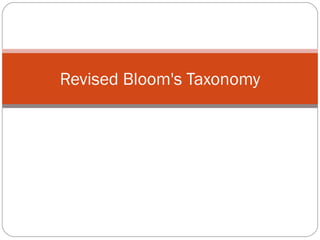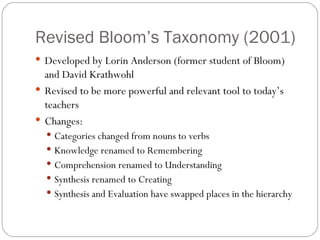Revised Blooms Taxonomy
- 3. Revised Bloomâs Taxonomy (2001) Developed by Lorin Anderson (former student of Bloom) and David Krathwohl Revised to be more powerful and relevant tool to todayâs teachers Changes: Categories changed from nouns to verbs Knowledge renamed to Remembering Comprehension renamed to Understanding Synthesis renamed to Creating Synthesis and Evaluation have swapped places in the hierarchy
- 4. Old New
- 5. New Terms Remembering Retrieving, recognizing, and recalling relevant knowledge from long-term memory Understanding Constructing meaning from oral, written, and graphic messages through interpreting, exemplifying, classifying, summarizing, inferring, comparing, and explaining Applying Carrying out or using a procedure through executing or implementing Anderson & Krathwohl, 2001, pp. 67-68
- 6. New Terms Analyzing Breaking material into constituent parts, determining how the parts relate to one another and to an overall structure of purpose through differentiating, organizing, and attributing Evaluating Making judgments based on criteria and standards through checking and critiquing Creating Putting elements together to form a coherent or functional whole; recognizing elements into a new pattern or structure through generating, planning, or producing Anderson & Krathwohl, 2001, pp. 67-68
- 7. Revised Bloomâs: 2-Dimensional Revised Bloomâs Taxonomy designed to be 2-dimensional instead of 1-dimensional Knowledge Dimension Factual Conceptual Procedural Meta-cognitive Cognitive Process Dimension Remember, Understand, Apply, Analyze, Evaluate, Create
- 8. 2-D Revised Bloomâs Taxonomy http://oregonstate.edu/instruct/coursedev/models/id/taxonomy/#table Knowledge Dimension Cognitive Process Dimension Remember Understand Apply Analyze Evaluate Create Factual List Summarize Classify Order Rank Combine Conceptual Describe Interpret Experiment Explain Assess Plan Procedural Tabulate Predict Calculate Differentiate Conclude Compose Meta-cognitive Appropriate Use Execute Construct Achieve Action Actualize
- 9. Simple Example: Goldilocks Remember : Describe where Goldilocks lived Understand : Summarize what the Goldilocks story was about Apply : Construct a theory as to why Goldilocks went into the house Analyze : Differentiate between how Goldilocks reacted and how you would react in each story event Evaluate : Assess whether or not you think this really happened to Goldilocks Create : Compose a song, skit, poem, or rap to convey the Goldilocks story in a new form Omaha Public Schools Teachersâ Corner:http://www.ops.org/reading/blooms_taxonomy.html
- 10. Remembering Actions Products Recognizing Quiz Listing Definition Describing Fact Identifying Worksheet Retrieving Test Naming Label Locating List Finding Workbook Reproduction
- 11. Understanding Actions Products Interpreting Recitation Exemplifying Summary Summarizing Collection Inferring Explanation Paraphrasing Show and tell Classifying Example Comparing Quiz Explaining List Label Outline
- 12. Applying Actions Products Implementing Illustration Carrying out Simulation Using Sculpture Executing Demonstration Presentation Interview Performance Diary Journal
- 13. Analyzing Actions Products Comparing Survey Organizing Database Deconstructing Mobile Attributing Abstract Outlining Report Structuring Graph Integrating Spreadsheet Checklist Chart Outline
- 14. Evaluating Actions Products Checking Debate Hypothesizing Panel Critiquing Report Experimenting Evaluation Judging Investigation Testing Verdict Detecting Conclusion Monitoring Persuasive speech
- 15. Creating Actions Products Designing Film Constructing Story Planning Project Producing Plan Inventing New game Devising Song Making Media product Advertisement Painting














